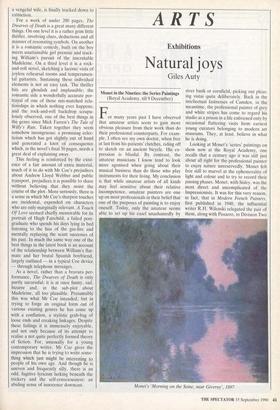ARTS
Exhibitions
Natural joys
Giles Auty
For many years past I have observed that amateur artists seem to gain more obvious pleasure from their work than do their professional counterparts. For exam- ple, I often see my own doctor, when free at last from his patients' clutches, riding off to sketch on an ancient bicycle. His ex- pression is blissful. By contrast, the amateur musicians I know tend to look more agonised when going about their musical business than do those who play instruments for their living. My conclusion is that while amateur artists of all kinds may feel sensitive about their relative incompetence, amateur painters are one up on most professionals in their belief that one of the purposes of painting is to enjoy oneself. Today, only the amateur seems able to set up his easel unashamedly by river bank or cornfield, picking out pleas- ing vistas quite deliberately. Back in the intellectual fastnesses of Camden, in the meantime, the professional painter of grey and white stripes has come to regard his studio as a prison in a life enlivened only by occasional flattering visits from earnest young curators belonging to modern art museums. They, at least, believe in what he is doing.
Looking at Monet's 'series' paintings on show now at the Royal Academy, one recalls that a century ago it was still just about all right for the professional painter to enjoy nature unreservedly. Monet felt free still to marvel at the ephemerality of light and colour and to try to record their passing phases. Monet, with Sisley, was the most direct and uncomplicated of the Impressionists. It was for this very reason, in fact, that in Modern French Painters, first published in 1940, the influential writer R.H. Wilenski relegated the pair of them, along with Pissarro, to Division Two
Monet's 'Morning on the Seine, near Giverny', 1897 of what he called the Realist/Impressionist movement. For Wilenski, Manet, Degas and Renoir were the unquestioned mas- ters. His main reason for this contention was that these three were more innovative and theoretical than the others. By con- trast, Wilenski's Second Division boys merely, in his words, 'continued and de- veloped the art created by Turner's land- scapes and Constable's landscape sketch- es'. No mean achievement here, of course. Cezanne said of Monet that he was 'only an eye, but what an eye'. No painter is solely an 'eye', but the empiricism of Monet's approach to the evanescent allied him to those contemporary scientists who were conducting optical experiments.
The exhibition on view now at the Royal Academy originated in Boston and is the most comprehensive demonstration yet of Monet's different series of works, ranging from the familiar haystacks, poplars, Rouen Cathedral, mornings on the Seine and Japanese bridges to lesser-known series such as those centred on the Creuse valley and Mount Kolsaas in Norway. Those responsible at the Royal Academy have hung the works intelligently and have clearly given thought to the precise tone of grey to paint the walls surrounding the paintings. The experience is meant to be a visual feast but I wonder how many others found the variety and awfulness of much of the framing as distracting as I did. Here we see priceless works presented sometimes in a manner which is both unsuitable and unflattering. Monet himself liked ornate, gilded frames and the two contemporary examples on view are the best of their type, contrasting sharply with a cheaper-looking species which I can best describe as Bour- nemouth baroque. Many of the frames deprive the spatial compositions within them of necessary air, cast shadows and exude a depressing vulgartiy which Monet, of all painters, can do without. If museums do not know how to present works there are those who can advise them. Clearly the responsibility does not rest here with our own Royal Academy, since all the works are borrowed.
The current show is throwing many of our leading critical lights into a consider- able quandary. No one can accept that Monet was trying to come to terms in paint simply with the visual experiences which moved him. Such an attitude is too unintel- lectual and anti-progressive for their tastes.
In short, Monet's paintings have to be visionary, symbolic and innovative to cut any long-term critical mustard. Certainly Monet finished most of his series paintings in the studio but this fact alone does not nullify his intention to glory in changing light and atmosphere. As a breed, modern art historians irritate me by their desire to judge past art by their own contemporary attitudes. Monet was not an abstract Ex- pressionist in embryo any more than azanne was a fledgling Cubist. All paint- ing is fiction of some kind but Monet's art is founded solidly in the natural world in which he gloried. While Monet, in his late fifties, rose regularly before dawn to ex- plore misty early morning light on the Seine for his series of paintings on that theme, his present-day counterpart tosses sleeplessly in bed generally grappling with nothing more rewarding than the mistiness of his own thinking, wondering some- times, no doubt, why the whole business of painting provides so little joy any more.



























































 Previous page
Previous page